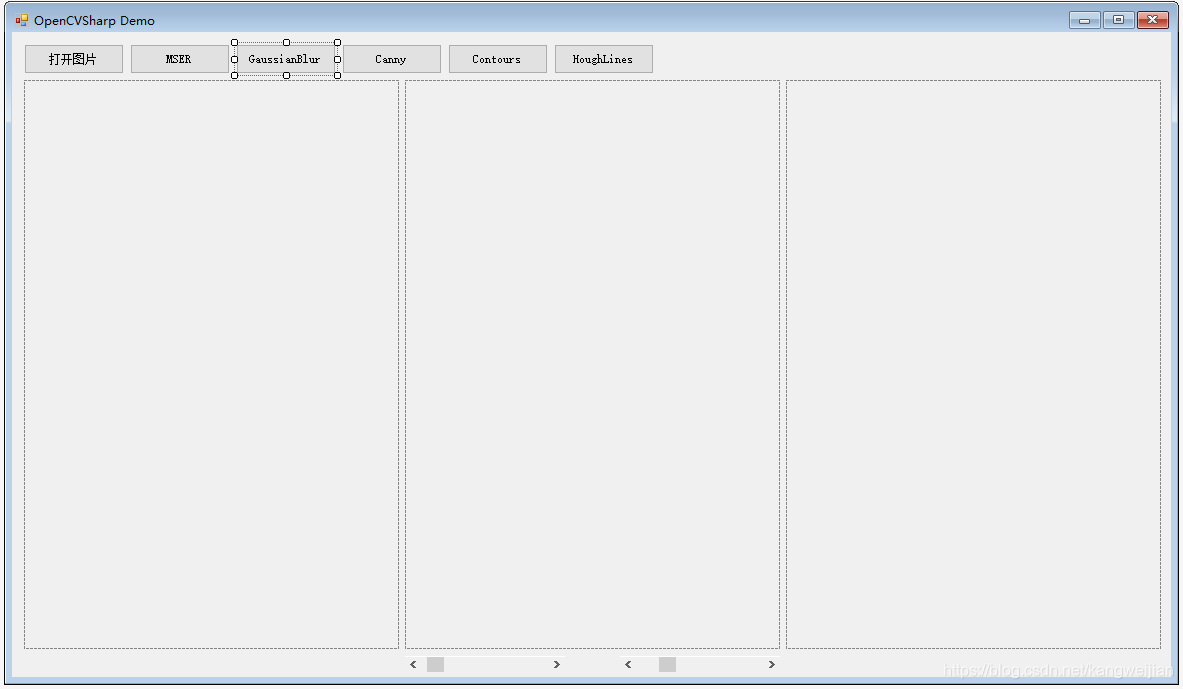文章目录
一、前文
Gaussian Blur,高斯模糊
减少图像噪声以及降低细节层次
高斯平滑也用于计算机视觉算法中的预先处理阶段,以增强图像在不同比例大小下的图像效果(参见尺度空间表示以及尺度空间实现)。 从数学的角度来看,图像的高斯模糊过程就是图像与正态分布做卷积。由于正态分布又叫作高斯分布,所以这项技术就叫作高斯模糊。
二、GaussianBlur高斯模糊算法流程

其中r是模糊半径,σ是正态分布的标准偏差。
在二维空间中,这个公式生成的曲面的等高线是从中心开始呈正态分布的同心圆。
分布不为零的像素组成的卷积矩阵与原始图像做变换。每个像素的值都是周围相邻像素值的加权平均。
原始像素的值有最大的高斯分布值,所以有最大的权重,相邻像素随着距离原始像素越来越远,其权重也越来越小。
三、界面布局
- 一个
Label - N个
Button - 三个
Picture

四、功能实现
4.1 打开图片
private void openFileBtn_Click(object sender, EventArgs e)
{
OpenFileDialog openfiledialog = new OpenFileDialog();
openfiledialog.Filter = "PNG Files (*.png)|*.png|JPG Files (*.jpg)|*.jpg|GIF Files (*.gif)|*.gif";
openfiledialog.RestoreDirectory = true;
if (openfiledialog.ShowDialog() == DialogResult.OK)
{
Console.WriteLine(openfiledialog.FileName);
fileName = openfiledialog.FileName;
//Mat src = new Mat("foo.png", LoadMode.Color);
Mat src = new Mat(fileName);
//Mat src = new Mat(fileName, ImreadModes.Color);
var frameBitmap = BitmapConverter.ToBitmap(src);
pictureBox1.Image?.Dispose();
pictureBox1.Image = frameBitmap;
}
}
4.2 GaussianBlur高斯模糊—源码
private void GaussianBlurBtn_Click(object sender, EventArgs e)
{
mInput = new Mat(fileName);
blur = new Mat(mInput.Rows, mInput.Cols, MatType.CV_8UC4);
Size ksize = new OpenCvSharp.Size(5, 5);
Point anchor = new Point(3, 3);
BorderTypes borderType = BorderTypes.Constant;
//Cv2.Blur(mInput, blur, ksize, anchor, borderType); //模糊
Cv2.GaussianBlur(mInput, blur, ksize, 0); //高斯模糊
srcPictureBox.Image = BitmapConverter.ToBitmap(mInput);
grayPictureBox.Image = BitmapConverter.ToBitmap(blur);
}
4.3 GaussianBlur高斯模糊—参数讲解
//
// 摘要:
// Blurs an image using a Gaussian filter.
//
// 参数:
// src:
// input image; the image can have any number of channels, which are processed independently,
// but the depth should be CV_8U, CV_16U, CV_16S, CV_32F or CV_64F.
//
// dst:
// output image of the same size and type as src.
//
// ksize:
// Gaussian kernel size. ksize.width and ksize.height can differ but they both must
// be positive and odd. Or, they can be zero’s and then they are computed from sigma*
// .
//
// sigmaX:
// Gaussian kernel standard deviation in X direction.
//
// sigmaY:
// Gaussian kernel standard deviation in Y direction; if sigmaY is zero, it is set
// to be equal to sigmaX, if both sigmas are zeros, they are computed from ksize.width
// and ksize.height, respectively (see getGaussianKernel() for details); to fully
// control the result regardless of possible future modifications of all this semantics,
// it is recommended to specify all of ksize, sigmaX, and sigmaY.
//
// borderType:
// pixel extrapolation method
public static void GaussianBlur(InputArray src, OutputArray dst, Size ksize, double sigmaX, double sigmaY = 0, BorderTypes borderType = BorderTypes.Reflect101);
ksize,高斯内核大小,ksize.width和ksize.height必须是正奇数,两者可以不相同,值越大越模糊sigmaX,Y轴方向的标准差,值越大越模糊sigmaY,X轴方向的标准差,值越大越模糊
五、运行效果图
- 从左到右
- 第一张是原图
- 第二张是GaussianBlur高斯模糊结果图
Size ksize = new OpenCvSharp.Size(3, 3);

Size ksize = new OpenCvSharp.Size(5, 5);

Size ksize = new OpenCvSharp.Size(15, 15);

觉得好,就一键三连呗(点赞+收藏+关注)























 2781
2781











 被折叠的 条评论
为什么被折叠?
被折叠的 条评论
为什么被折叠?










